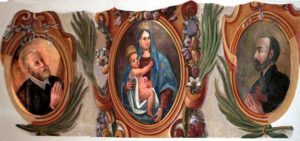 By Felice Ruffini in Camillianum – Books of Camillian history and spirituality – No.27, 2009, pp.475-488.
By Felice Ruffini in Camillianum – Books of Camillian history and spirituality – No.27, 2009, pp.475-488.
In the sacristy of the Shrine of St. Camillus at Bucchianico, particular attention of the pilgrims is reserved to the fresco of the triptych dedicated to the Blessed Virgin with the Saints Philip Neri and Camillus de Lellis on the sides, because the Camillian Rector who is the “guide” transmits the “Marian message of our Saint “.
Because for obvious reasons those who accompany them must use summary information, we are urged to roll out this “piece” with the hope of making useful service.
The origins
The Convent and the Church were built on the site where there was an old palace given to Father Camillus by the Marquis Marino Caracciolo, Prince of Santo Buono and feudal lord of Bucchianico, in the demolition of which our saint besought from God the safety of those who remained under a sudden collapse. A fresco in the same Sacristy remembers the moment.
So it is not a pre-existing image of the Blessed Virgin which was later completed by the two Saints, and assumed by the local Camillian community.
About the year of execution we have good reason to believe that it is 1690, according to the “legend” inscribed in the cloister of the adjoining convent, where there are scenes of the life of the Saint, documented by ancient photographs.
Although there is no inscription that assigns a “title” to this image, we present it as “Salus Infirmorum”, Our Lady of the Ministers of the Sick, also comforted by the opinion of experts who say “Every depiction of Our Lady has historical content and refers to a determined event in her life, or to an intervention in the history of the church or of the saints “.
IT HAD TO BE ALL HIS
The contemporary historian of the Saint, the Camillian Fr. Sanzio Ciactelli, in drafting the moment of the “Solemn First Profession”, exposes with great care the historical steps made by the nascent “Congregation of the Ministers of the Sick”, exalting that all coincide with solemn feasts of the Blessed Virgin Mary. Reviewing the occasional difficulties to immediately implement the Decree of approval of Pope Gregory XIV, he concludes by affirming that he “also wished that he had been held to do so until the day of his Immaculate Conception. It was of extreme satisfaction to all his companions for the ardent desire that they had to always be under the perpetual protection and very faithful Patronage of Immaculate Virgin.”
It is unequivocal that at the decisive and solemn moment of the transition from a small “society”, to the rank of “Religious Order” in the Church, with the first “Solemn Profession”, thus giving to the history that Mid-August dream at St. James Hospital, Camillus and his Religious recognize the high “Patronage of the Mother of God” entrusting the present and future religious to her, and all the pastoral action at the service of the sick and suffering man. It is the “patronage of Mary” that already in the thirteenth century the Latin hermits of Carmel had adopted for the Order and extended it to their Church. The act indicates a profound bond established between the one who is at the service of the Church and the Saint to whom the place of worship is dedicated, a personal consecration ratified by religious profession. Knowing the excellent and intense relationships that Father Camillus will have throughout his life with authoritative and qualified Religious of Carmel, it is safe to assume that they had a strong influence on his “existential Marian dimension”, which he then transmitted to his Religious. In particular, the presence of this “patronage of Mary” can be seen to be present from the beginning in the many churches officiated by the Ministers of the Infirm dedicated to the Virgin Mary in surprising numbers.














Camillians on Facebook
Camillians on Twitter
Camillians on Instagram